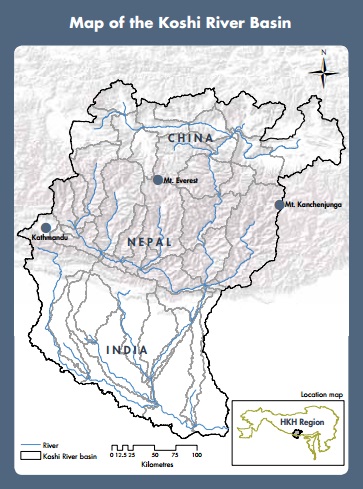This is part of a special series from thethirdpole.net exploring the management of Asia’s transboundary rivers – based on field research by journalists from India, Nepal and Bangladesh, in partnership with the Asia Foundation and Skoll Global Threats Fund.
Also read:
– Photo essay: The nowhere people
– Protests scupper India-Nepal dam
– Koshi flood victims struggle on
– Farakka barrage leads to water crisis in Bangladesh
In 2008, Nepal and India experienced dramatic floods, when the Koshi River shifted, breached an ill-maintained embankment and inundated vast areas of Nepal and northern Bihar.
The floods caused tremendous loss of human life and property, affecting 3.5 million people.
The river shifted 120 km, the largest river migration in the world.
The flood was not a natural phenomenon caused by heavy rainfall. It was the result of a massive build-up of silt – part of the heavy sediment load carried by the Koshi down from the Himalayas. The construction of embankments had over time constricted the natural free swing of the river, making its behaviour unpredictable and sudden, invoking disaster. Poorly planned rail and road networks built over flood plains caused severe drainage congestion and waterlogging.
The Koshi River – the largest tributary of the Ganga – flows through Tibet, Nepal, and India, in an area of heavy rainfall and with soil erosion in its catchment area. This results in frequent floods downstream. The 2008 disaster sparked political tensions, with politicians and the media in Kathmandu and Patna (the capital of Bihar) blaming each other for the disaster.

In 2013 monsoon floods and landslides in the Mahakali River basin, another transboundary river, wreaked havoc in Nepal and the Indian states of Uttarakhand and Uttar Pradesh. And in 2014 landslides blocked the Sunkoshi River, killing over 150 people in Nepal and threatening downstream India.
In all these cases, the lack of accurate data and public information obscured the root causes of the floods, spreading rumours among flood victims.
Countries in South Asia have signed numerous bilateral agreements and treaties and set up various joint commissions in an attempt to share the water of the Brahmaputra, Indus and Ganga and their tributaries and to manage floods. Yet details about how these agreements are being implemented, and about the water that flows along these rivers, are notoriously hard to access.
Governments regard hydrological data about transboundary rivers as “classified” information, a matter of national security. Negotiations between countries are usually conducted in secrecy between bureaucrats, breeding public mistrust and undermining cross-border cooperation.
Mistrust between countries colours media coverage of disasters. In India headlines tell of Nepalis opening floodgates; while in Nepal similar headlines accuse India of shutting barrages to create rapid pooling of water upstream.
This shuts down space to thrash out the real causes of such disasters and possible ways to prevent future destruction.
Reporting from the ground
In this context, thethirdpole.net, in partnership with the Asia Foundation and the Skoll Global Threats Fund, offered fellowships for journalists from Nepal, India and Bangladesh to travel along sections of these transboundary rivers and carry out their own research. They aimed to find out how decisions taken by politicians, diplomats and engineers affect people living along the river banks and how information flows, or stymies, between seats of power and local villages.
Deepak Adhikari visited Sunsari district along the Koshi River in Nepal, where people are protesting India’s construction of the Sapta Koshi High Dam. While politicians promise the dam will provide irrigation for farmland, improved navigation and flood control, local people fear they will be displaced without proper compensation.
Deepak also describes how victims of the 2008 floods are still struggling to grow food in the Terai plains of southern Nepal. Embankments built to protect people from the floods have magnified flood damage and caused waterlogging, making life even more precarious.
Arati Kumar Rao travelled down the Ganga to near the Bangladesh border in West Bengal, where the Farakka Barrage has obstructed the natural course of the river, creating a dumping ground for silt and creating a new tribe of people who are environmental refugees.
Millions of people have been caught in a no man’s land between the moving braids of the Ganga – on the border between the two countries. These people are left homeless and stateless, with neither country willing to provide support or essential services. The government has ploughed huge amounts of money into trying to fortify river banks that are continually washed away – with only the contractors and cement companies ending better off.
Further downstream Abu Bakar Siddique sets off where the Ganga becomes the Padma in Bangladesh. Here, construction of the Farakka barrage has reduced river flow, making it impossible for farmers to irrigate rice paddy. Families have been forced to migrate from the shoals of the river to the mainland in search of a better life. Siddique describes how years of poor crop yields and the increasing price of irrigation have left families heavily indebted and on the move again.
These reports feed into a broader tale of the challenges of water management, or mismanagement, in South Asia, especially along transboundary rivers. Inappropriate engineering solutions have exacerbated flooding, displaced people and left once fertile lands barren.
We hope these reports show the human face of these problems and help spur discussion that will lead to a cooperative and sustainable development.

